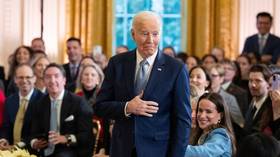Trump is the only person in Washington who wants India and China to reconcile. Here’s why his plan won’t work

As tensions rise between Asian giants in the Himalayas, US president is looking to keep the peace. Washington’s policy-makers, who seek to pit the Indians against the Chinese, may be as naïve as Trump.
As India and China engage in another round of their decades-old border dispute in the Himalayas, Donald Trump could not resist the temptation to offer his services to “mediate and arbitrate” between the two Asian giants.
Trump’s offer fell flat as both Delhi and Beijing immediately made it clear that they did not need mediators. When proposing mediation to India and China, Trump was perhaps inspired by his recent success in bringing about an OPEC+ deal that ended a brutal oil price war between Saudi Arabia and Russia.
If he was able to reconcile such formidable operators as Russian President Vladimir Putin and Saudi Crown Prince Mohammed bin Salman, why not pull off the same feat with Indian Prime Minister Narendra Modi and Chinese President Xi Jinping, with both of whom Trump boasts excellent personal relationships?
Also on rt.com ‘Aggressive confrontation’ between Indian & Chinese troops causes injuries on both sides, reports claimThere are at least two reasons why Trump’s intervention in the Sino-Indian dispute went nowhere. Firstly, it is difficult to be an effective mediator or arbiter in international politics if you don’t have leverage over the parties in question.
You need to be able to provide incentives for the sides to comply with your mediation, or punishments if they don’t. In the Russian-Saudi case, the US wielded a lot of leverage as a huge producer of oil capable of moving the global energy market. However, it is not clear what rewards or penalties the US has in reserve for China and India. Most likely there are none.
Second, the best mediator is one that is perceived as unbiased and impartial. On this count the White House has an obvious handicap, since the US views India as a crucial partner and friend, while China is considered a competitor and rival.
Also on rt.com Thanks, but no thanks? Trump rebuffed after offering to mediate India-China border standoffAmerica blames China
Around the same time as Trump was offering himself as an arbiter, senior officials in Washington were not shy in pointing out who, in their view, was the culprit and aggressor in the Himalayan standoff.
Alice Wells, principal deputy assistant secretary of state for South and Central Asia, called China’s behavior “aggression, the constant attempt to shift the norms, to shift what is the status quo, that has to be resisted whether it’s in the South China Sea… or whether it’s in India’s own backyard, both on land as well as in the Indian Ocean.”
It is telling that, compared to American officials, even Indian observers sound less accusatory towards China when analyzing what is behind the current spike in border tensions. For example, Lt Gen H S Panag argues that China’s political aim is to maintain the “status quo,” – which Beijing fears can be disturbed by the continued growth of the Indian strategic assets in the disputed border area – rather than trying to take away more territory from India. There are views in India that recognize New Delhi’s own share of historical responsibility in creating and exacerbating the border dispute and call for a compromise with China.
Also on rt.com Conflicts w/ India, US, Hong Kong: Is China on the brink?However, the final settlement of the border question between India and China may not be something that Washington would truly desire. Trump may be about the only person in the US government who wants India and China to make peace, provided he gets the credit – and maybe the Nobel Prize – for this.
But the guys who populate the State Department, the Pentagon and think tanks in Washington do not care about whether Trump gets the Nobel Prize. Unlike Trump’s, their mindset is decidedly geopolitical. And that essentially means thinking in terms of the balance of power. They understand that a rising and ambitious India is the only realistic counter-balance against China. There are just no other candidates for this role. Russia is in cahoots with China. Japan is a declining and militarily weak power. The ASEAN bloc of Southeast Asian countries seems like a herd of cats who are no match to the monolith of Chinese power.
Divide and conquer
American decision-makers also know that, in order to maintain control over Eurasia, the US needs to keep this super-continent divided against itself, which means never allowing a true rapprochement between Asia’s two biggest powers, India and China.
To be sure, it is nationalism in India and China that prevents Beijing and Delhi from ending their antagonism in the first place. But Washington is not going to make it any easier for them. Hence American attempts to lure India into coalitions and arrangements, such as the Quad, aimed at countering China.
Also on rt.com India rolls out red carpet for hundreds of American firms that Washington wants out of China – reportDelhi is so far playing along, happily supporting the discourse about “the two greatest fellow democracies.” But India is highly pragmatic. It is not going to carry water for Washington by becoming, as many American strategists hope, the main frontline state against China.
India’s strategy seems to be to obtain the maximum possible benefits from its partnership with the US, while evading any meaningful participation in the American-led efforts to contain China. In this sense, Washington’s policy-makers, who seek to pit the Indians against the Chinese, may be as naive as Trump with his peace-making initiatives.
Like this story? Share it with a friend!
The statements, views and opinions expressed in this column are solely those of the author and do not necessarily represent those of RT.













